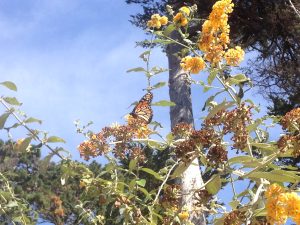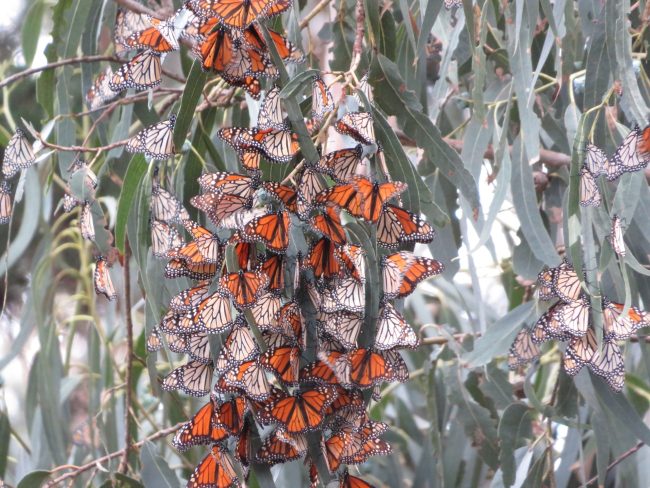The 2022 monarch butterfly season launched with heartwarming news this month: the western population, which migrates along the California coast and numbered about 2,000 butterflies in 2020, jumped to almost 250,000 butterflies in 2021.
Most monarch scientists and monarch butterfly followers were stunned.
After predictions labeled the Americas’ most iconic insect “near extinction” last year, the butterflies leapt back to viability as historic wildfires, a “cyclone bomb” rain event, record air pollution and the COVID pandemic dominated California news.
“That tells you how much I know,” Chip Taylor, founder of Monarch Watch at the University of Kansas at Lawrence, told the Toronto Globe and Mail. “And that tells you how much we all know.”
In the same article, Emma Pelton of the Xerces Society, told reporter Nathan VanderKlippe the butterfly rebound represented a “rare ray of hope that the population is more resilient than we thought.”
Xerces organizes the annual west coast monarch counts.

Monarch butterfly rests at Pismo Beach sanctuary in 2015. Photo by Monika Maeckle
So what is the reason for the dramatic boost in west coast monarch butterflies?
In a post on the Xerces website titled “The Bounciness of Butterflies,” the invertebrate conservation organization based in Portland, Oregon, acknowledged that insect populations are famously volatile, with extreme fluctuations from year to year, depending on conditions. That said, Xerces suggested one reason for the population increase could be the year-round presence of non native milkweeds in the San Francisco Bay area.
Gardeners are increasingly planting Tropical milkweed Asclepias curassavica, and African Balloon plant, Gomphocarpus physocarpus, in their yards and landscapes. Unlike native milkweeds, these species often do not die back in the winter. The presence of these year-round host plants on which monarch butterflies can lay their eggs, allows the butterflies to continue to reproduce and grow their populations.
Xerces cited a recent paper by David James, an entomologist and monarch researcher at Washington State University, which made the case that adult monarchs, eggs and larvae were common during winter and most of spring. The butterflies utilized the non-native milkweeds and multiple nectar sources from native and ornamental plants. Evidence from weekly counts and tagged butterflies indicated increased dispersal to the north and east during late April-mid-May, suggesting the butterflies participated in the spring migration to the Pacific Northwest and eastern California.
“In short, there is a possibility that winter breeding monarchs are contributing to the migration, and this may be more true in certain years when conditions are favorable,” Xerces concluded.
James, who has studied monarchs in Australia and witnessed what he called their “demonstrated resilience to changed conditions,” said via email “I’m probably the only unsurprised monarch scientist!”
In a post on the Monarch Watch website, Taylor pondered what appeared to be the impossible mathematics of such a small population of surviving butterflies generating 200,000 offspring.
Taylor speculated that by the time the 2021 spring California migration began, only 441 females of the 2,000 counted survived the winter.
“Is it possible for 441 females to produce a population of 200,000 monarchs in 3-4 generations? I don’t think so,” he wrote.
He then suggested three possible reasons for the dramatic increase in western monarchs.
- Monarchs originating from Mexico recolonized the breeding areas in the West in March and April.
- Thousands of overwintering monarchs clustered at sites unknown until this year.
- Some monarchs that breed along the coast during the winter months responded to seasonal cues in March and moved inland where they produced a first generation that colonized the summer breeding ranges in the West, in particular areas to the east and north of California.
“With only one year of a population increase, it is impossible to say whether this is the population clawing its way back from the brink or a blip in the continuation of the migration’s decline,” Pelton wrote on the Xerces website. “We won’t know this until we have more years with either more or fewer monarchs.”

Don’t forget to vote! Engelmann’s daisy or Gayfeather? Click to vote for 2022 Unofficial Pollinator Plant of the Year
In short, we don’t understand how or why this western butterfly population boom occurred, but we are delighted that it did.
Meanwhile, the eastern monarch butterfly population which migrates east of the Rocky Mountains from Canada, through the midwest and the Texas funnel and into Mexico, is still being tallied. Taylor predicted a decrease this year but reports from the roosting sites in Mexico are upbeat.
Taylor admitted his estimates might be overly pessimistic. An early report from El Rosario, one of the 12 sanctuaries in the Mexican mountains, offered that the population this year was about a third larger than last year. In early December, the counts of trees occupied by monarchs at Chincua, Cerro Pelon and Herrada, three other roosting sanctuaries, were all greater than expected.
“I’d be delighted to be wrong,” Taylor wrote.
The World Wildlife Fund typically announces the eastern monarch butterfly population count in February.
TOP PHOTO: Monarch butterflies cluster in Pismo State Beach Monarch Butterfly Grove in California. Photo by Lisa Damerel via Xerces Society
Related posts:
- Dutch journalist visits Texas Butterfly Ranch, finds monarchs may choose to stay at home
- Candy Roach’s pollinator garden works overtime as bachelor pad for solitary bees
- Q & A with Andy Davis
- Popularity of pollinator gardens growing in areas prone to drought
- Planting a butterfly garden? Here’s tips on how to do it
- Mostly native butterfly garden outperforms lawn every time
Like what you’re reading? Don’t miss a single post from the Texas Butterfly Ranch. Sign up for email delivery, like us on Facebook, or follow us on Twitter, @monikam.


On Aug. 29 last summer I filmed fall migrants flying SW across a farm road in southwestern Minnesota at the rate of 20 butterflies per minute: https://youtu.be/Q1ugyulER6Q
I live in the San Francisco Bay area and I have observed numerous Monarchs throughout the year going about their daily business. Life finds a way!
I live in the San Francisco Bay area and I have observed numerous Monarchs throughout the year going about their
daily business. Life finds a way!
This is wonderful news. I believe that in 2020, the butterflies went elsewhere rather than their usual sites – hence the low numbers. I also think there is more than one reason for the fabulous count this year. Chip Taylor cited three reasons; probably some combination.
Whatever the reason, it is wonderful!!
iNaturalist shows 401 monarch sightings in December, a few cats but mostly adults. Will these latecomers make it to Mexico?
Doubtful.
I think I might be late to comment on this article but it is entirely possible that Covid could have influenced the increase. My supposition is that the lock down during Covid could have resulted in families and individuals alike to partake in raising caterpillars in their own homes as part of their own enrichment activities. I cannot entirely be certain of this but from what I’ve gathered of home activities I can only assume this also contributed to their increase in numbers but I would love to hear someone else’s thoughts on this theory.
I’ve done butterfly rearing For the past several years. I collect the leafs with eggs and keep them In containers. Though I much prefer them be in the wild, those damn flies were laying their Eggs in the caterpillars and killing them. I clean their containers and feed them multiple times a day, cuz they sure know how to gobble down that milkweed. But this is the process I committed myself for a few months every year, Last year I set free 225 monarchs. So to hear the numbers increased as much as they did just warms my heart. Butterflies seemed to arrive a little late this year, but it’s in full motion at the moment. I already know this year is going to be even more than last year.